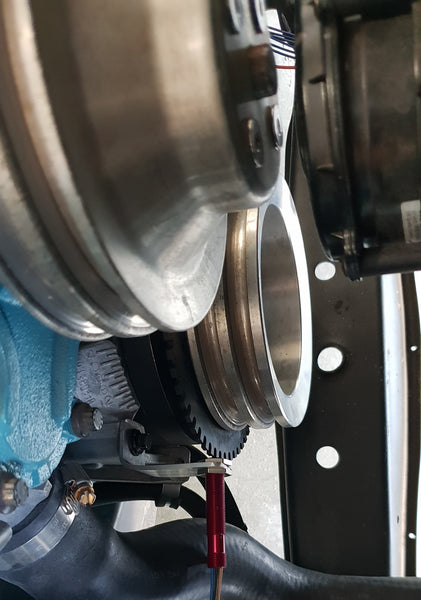
What parts do you need to EFI swap your carb classic? Workshop Manuel explains...
if you've seen the LATEST EPISODE on Marty's classic '82 RX-7 Mazda, you'll see the lads are jumping into swapping from a carburettor to electronic fuel-injection. Many old school car fans see EFI as some kind of overly-complex mystery, but the truth is that fuel-injection is incredibly easy to install on an old car today.
I went through this job on my 1964 Pontiac, so here is what parts you'll need, and how to hook it up:

First, you'll need an ECU. We use Haltechs because we have used them for years, know a bunch of tuners who can PgUp them like pros, and rate their after-sales support. It is these kinds of facts which should guide your decision as to which brand of ECU you choose for your project.
The best way to spec an ECU out for your project is to find a tuner you want to use, and talk to them about your goals. You will also need to spec your ECU to suit the engine you're using, because basic cars will only need a simple, entry-level ECU. However, engines with a lot of cylinders, fuel pumps, nitrous, or other extras, will need an ECU with more inputs and outputs.

Getting the fuel into the engine is the next job. Carburettor systems typically use under 10psi (often 6psi), while common fuel-injection set-ups run around 58psi. If you're lucky you can buy a fuel tank which is set-up for EFI with a high-pressure lift pump that is submerged inside the tank, or can get one made like this unit.
I used an "MRA" EFI pump unit from a late model V8 VE Holden Commodore as it meant I could just run a single AN6-sized fuel line up to the engine, simplifying the plumbing. This would supply 500hp worth of fuel, and could be upgraded with higher-output pumps.
The other way to plumb a fuel system in is to use the stock carburettor-spec tank plumbed into a surge tank, which then holds an EFI-spec fuel pump or two. This set-up will typically require more plumbing, can be noisier due to having the pumps mounted outside the tank, and can cause fuel smell to get into the car.

Once the fuel is at the engine you need to get it injected so it can make glorious horsepower. Marty was able to buy a complete throttle body/manifold set-up suited to port-style injection, while I had my Pontiac's intake manifold modified to have injector bosses welded in, with stock LS3 fuel injectors being used.
You can get "throttle body injection" units, but these are basically just electronic carburettors. There are benefits to having the injector spray pattern from port-injection rather than mounting it all in the throttle body.
 I used a pair of FAST four-barrel air-only throttle bodies. They come with an intake air temp sensor, a throttle position sensor, and an idle control valve, though I had to remove the idle control valve as my ECU couldn't control a stepper-style set-up. I used an EFI Hardware kit to run a two-wire Bosch idle control valve, and simply blanked off the valves on the FAST throttle bodies.
I used a pair of FAST four-barrel air-only throttle bodies. They come with an intake air temp sensor, a throttle position sensor, and an idle control valve, though I had to remove the idle control valve as my ECU couldn't control a stepper-style set-up. I used an EFI Hardware kit to run a two-wire Bosch idle control valve, and simply blanked off the valves on the FAST throttle bodies.
The ECU needs the information about the air temperature and where the throttle position is, so it can ensure the engine is running properly. It also needs to know where the crankshaft is at in its cycle, which is why you need to set up a crank trigger.

There are a lot of different ways to set up a crank trigger with different tooth counts and sensors. I used a 58-tooth wheel from Holley, which I had machined to fit my car's crank pulley. I set cylinder #1 at Top Dead Centre and fitted the wheel so it all lined up with the factory timing marks.
As the engine spins this wheel turns in time with it, and the sensor reads the missing teeth, so the ECU knows that everything is firing in time as you tell the ECU what the firing order is and when it should be igniting the air/fuel mixture.

Igniting the fire is the job of the ignition system (the clue is in the name). Old school cars use a distributor, which spins with the engine, while later model cars use coilpacks or coil-on-plug technology as it provides stronger, more stable spark.
While you can get distributors which can be adapted to work with EFI, I chose to upgrade my ignition system with coilpacks off an LS V8. With most older engines you can't simply remove the distributor as the dizzy also drives the oil pump, and so this meant I had to get a special plug made. As it turned off the camshaft I could have adapted this to be a cam position sensor.

With eight coilpacks mounted in the engine bay that was all that was required to convert my 1960s V8 to a late-model-style EFI. While it isn't as simple as just plopping a carburettor onto an intake manifold, the cold-starting and throttle response are worth the effort!

![Limited Edition Car Poster [AUTOGRAPHED]](http://mightycarmods.com/cdn/shop/files/ONLY_45AUD_480x480.png?v=1765858723)


